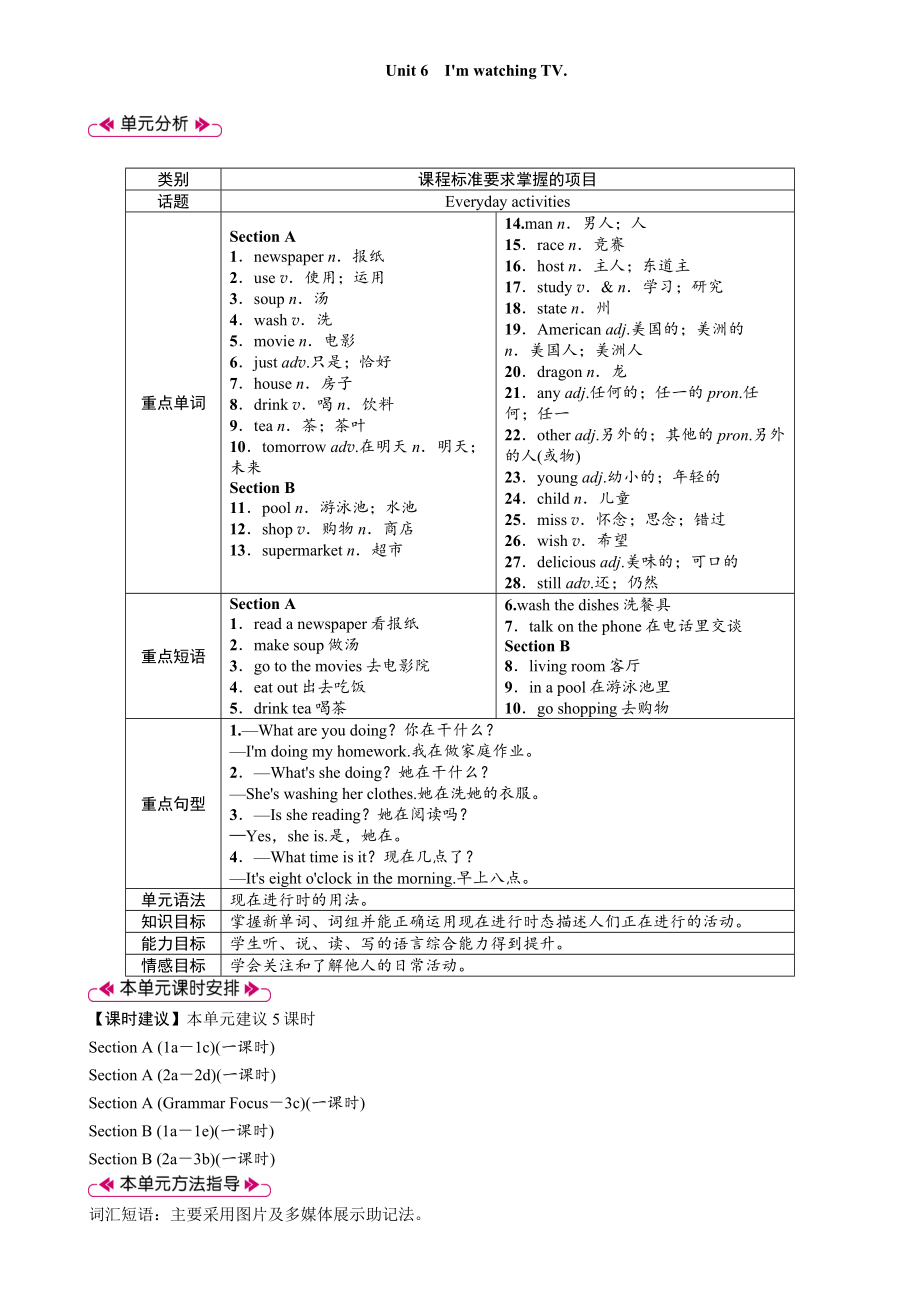《人教版七年級(jí)下冊(cè)Unit 6 I'm watching TV-Section A(1a_2d)教案》由會(huì)員分享,可在線閱讀����,更多相關(guān)《人教版七年級(jí)下冊(cè)Unit 6 I'm watching TV-Section A(1a_2d)教案(3頁(yè)珍藏版)》請(qǐng)?jiān)谘b配圖網(wǎng)上搜索��。
1���、Unit 6 I'm watching TV.
類別
課程標(biāo)準(zhǔn)要求掌握的項(xiàng)目
話題
Everyday activities
重點(diǎn)單詞
Section A
1.newspaper n.報(bào)紙
2.use v.使用;運(yùn)用
3.soup n.湯
4.wash v.洗
5.movie n.電影
6.just adv.只是���;恰好
7.house n.房子
8.drink v.喝 n.飲料
9.tea n.茶�;茶葉
10.tomorrow adv.在明天 n.明天��;未來(lái)
Section B
11.pool n.游泳池���;水池
12.shop v.購(gòu)物 n.商店
2�����、
13.supermarket n.超市
14.man n.男人��;人
15.race n.競(jìng)賽
16.host n.主人���;東道主
17.study v.& n.學(xué)習(xí);研究
18.state n.州
19.American adj.美國(guó)的��;美洲的 n.美國(guó)人�����;美洲人
20.dragon n.龍
21.a(chǎn)ny adj.任何的;任一的 pron.任何�;任一
22.other adj.另外的;其他的 pron.另外的人(或物)
23.young adj.幼小的����;年輕的
24.child n.兒童
25.miss v.懷念;思念��;錯(cuò)過(guò)
26.wish v.希望
27.d
3����、elicious adj.美味的�;可口的
28.still adv.還;仍然
重點(diǎn)短語(yǔ)
Section A
1.read a newspaper看報(bào)紙
2.make soup做湯
3.go to the movies去電影院
4.eat out出去吃飯
5.drink tea喝茶
6.wash the dishes洗餐具
7.talk on the phone在電話里交談
Section B
8.living room客廳
9.in a pool在游泳池里
10.go shopping去購(gòu)物
重點(diǎn)句型
1.—What are you doing��?你在干什么�����?
4���、—I'm doing my homework.我在做家庭作業(yè)��。
2.—What's she doing����?她在干什么?
—She's washing her clothes.她在洗她的衣服����。
3.—Is she reading?她在閱讀嗎�����?
—Yes�,she is.是,她在���。
4.—What time is it�?現(xiàn)在幾點(diǎn)了����?
—It's eight o'clock in the morning.早上八點(diǎn)。
單元語(yǔ)法
現(xiàn)在進(jìn)行時(shí)的用法�。
知識(shí)目標(biāo)
掌握新單詞、詞組并能正確運(yùn)用現(xiàn)在進(jìn)行時(shí)態(tài)描述人們正在進(jìn)行的活動(dòng)����。
能力目標(biāo)
學(xué)生聽(tīng)���、說(shuō)、讀����、寫的語(yǔ)言綜合能力得到提升。
情
5�����、感目標(biāo)
學(xué)會(huì)關(guān)注和了解他人的日?��;顒?dòng)。
【課時(shí)建議】本單元建議5課時(shí)
Section A (1a-1c)(一課時(shí))
Section A (2a-2d)(一課時(shí))
Section A (Grammar Focus-3c)(一課時(shí))
Section B (1a-1e)(一課時(shí))
Section B (2a-3b)(一課時(shí))
詞匯短語(yǔ):主要采用圖片及多媒體展示助記法����。
基本句子:采用多媒體展示及交際法(利用多媒體展示兩人進(jìn)行交際時(shí)的情景)。
語(yǔ)法:主要通過(guò)交際����、練習(xí)讓學(xué)生掌握學(xué)會(huì)問(wèn)答正在進(jìn)行的活動(dòng)。
第一課時(shí) Section A (1a-1c)
主備內(nèi)容
S
6��、ection A (1a-1c)
教學(xué)目標(biāo)
【知識(shí)目標(biāo)】
Important words:newspaper,use��,soup���,wash
Important phrases:watch TV��,read a newspaper����,make soup��,wash the dishes����,talk on the phone
Important sentences:
1.—What's he doing?
—He's using the computer.
2.—What are they doing?
—They're listening to a CD.
【能力目標(biāo)】鍛煉學(xué)生的聽(tīng)說(shuō)能
7、力�。
【情感目標(biāo)】關(guān)注和了解他人的日常活動(dòng)���。
教學(xué)重難點(diǎn)
重點(diǎn):1.本課時(shí)重點(diǎn)單詞和詞組�。
2.詢問(wèn)他人正在干什么及回答的句型�。
難點(diǎn):正確使用目標(biāo)語(yǔ)言和現(xiàn)在進(jìn)行時(shí)態(tài)在真實(shí)情境中溝通交流。
教法學(xué)法
情景交際法,任務(wù)型教學(xué)法���,聽(tīng)說(shuō)課的“3P”教學(xué)模式�。
Step 1 自主學(xué)習(xí)
【新詞自查】
根據(jù)句意及漢語(yǔ)提示填寫單詞或短語(yǔ)���。
1.—Do you know how to __use__(使用) the machine(機(jī)器)?
—Yes�����,I do.
2.—Where is your grandfather?
—He is __reading__a__new
8���、spaper__(看報(bào)紙) in the room.
3.—What is Lucy doing?
—She is __washing__the__dishes__(洗碗) in the kitchen.
4.—Is Barry __watching__TV__(看電視) now?
—No,he isn't.He is __talking__on__the__phone__(在電話中交談).
5.Mom is making __soup__(湯) for us.
Step 2 情景導(dǎo)入
【參考案例】
(Show some pictures that some people ar
9����、e doing something.Or ask some students to do actions.The teacher asks and the students answer.)
Teacher:What's he doing?
Student 1:He's singing.
Teacher:What's he doing?
Student 2:He's watching TV…
設(shè)計(jì)意圖:通過(guò)提問(wèn)引出本節(jié)課的知識(shí)目標(biāo),在師生問(wèn)答中自然而然導(dǎo)入新課�。
Step 3 完成教材1a-1c的任務(wù)
【操作案例】
1.先觀察1a中的圖片��,盡可能多地說(shuō)出他們的活動(dòng)����。
2.
10、將所給的短語(yǔ)和圖片中的活動(dòng)相匹配,并朗讀圖片中的對(duì)話����,練習(xí)此對(duì)話。
3.認(rèn)真聽(tīng)錄音�,將Jenny、John以及Dave和Mary正在進(jìn)行的活動(dòng)找出來(lái)�����,完成1b的任務(wù)�����。
4.再聽(tīng)一遍錄音��,學(xué)生跟讀����,模仿語(yǔ)音語(yǔ)調(diào)。
5.讓學(xué)生兩人一組就1a圖片中的人物活動(dòng)仿照1c進(jìn)行對(duì)話練習(xí)�����,邀請(qǐng)幾組學(xué)生表演對(duì)話���。
設(shè)計(jì)意圖:聽(tīng)說(shuō)結(jié)合�,第一時(shí)間向?qū)W生傳達(dá)語(yǔ)言目標(biāo),通過(guò)結(jié)對(duì)對(duì)話練習(xí)�����,語(yǔ)言目標(biāo)得以強(qiáng)化���。
知識(shí)點(diǎn)撥
1.現(xiàn)在進(jìn)行時(shí)態(tài)
(1)我正在看電視���。I am watching TV.
這是現(xiàn)在進(jìn)行時(shí)態(tài)的肯定句形式,其結(jié)構(gòu)為:主語(yǔ)+be+v.-ing+其他.其中be動(dòng)詞隨主語(yǔ)的人稱和數(shù)的變化而變化
11�����、���,當(dāng)主語(yǔ)是第三人稱單數(shù)時(shí)用is����,主語(yǔ)是第二人稱和名詞復(fù)數(shù)時(shí)用are����,主語(yǔ)是I時(shí)用am。
(2)你正在做什么����?What are you doing?
這是一個(gè)現(xiàn)在進(jìn)行時(shí)態(tài)的特殊疑問(wèn)句。其結(jié)構(gòu)為:特殊疑問(wèn)詞+be(am/is/are)+主語(yǔ)+v.-ing+其他��?
2.現(xiàn)在分詞的構(gòu)成
(1)read—reading�����,watch—watching��,talk—talking
一般直接在動(dòng)詞后加-ing�����。
(2)write—writing�,come—coming
以字母不發(fā)音的e結(jié)尾的去掉e再加-ing.
(3)swim—swimming,run—running�,begin—beginni
12、ng
一個(gè)元音字母加一個(gè)輔音字母結(jié)尾且末尾只有一個(gè)輔音字母的重讀閉音節(jié)詞要雙寫這個(gè)輔音字母再加-ing���。
Step 4 板書設(shè)計(jì)
Section A (1a-1c)
Important words:newspaper����,use,soup��,wash
Important phrases:watch TV���,read a newspaper���,make soup,wash the dishes�����,talk on the phone
Important sentences:
1.—What's he doing?
—He's using the computer.
2.—What are they doing?
—They're listening to a CD.
本課時(shí)以師生對(duì)話自然地引出新課��,通過(guò)聽(tīng)說(shuō)訓(xùn)練�����、對(duì)話表演���,強(qiáng)化語(yǔ)言目標(biāo)��,鼓勵(lì)學(xué)生參與到課堂中來(lái)���。
 人教版七年級(jí)下冊(cè)Unit 6 I'm watching TV-Section A(1a_2d)教案
人教版七年級(jí)下冊(cè)Unit 6 I'm watching TV-Section A(1a_2d)教案

